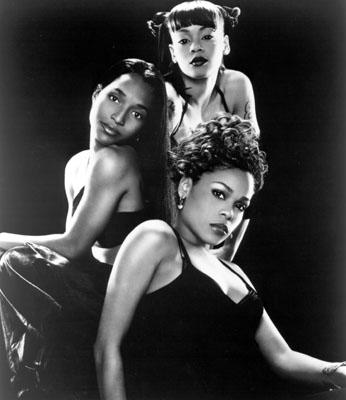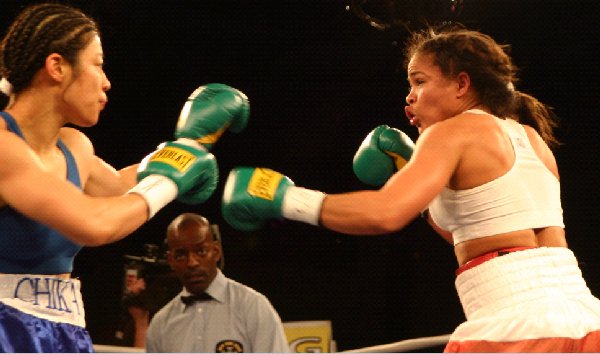 |
||||
|
From Girl to Woman to Grrl
From Girl to Woman to Grrl: (Sub)Cultural Intervention and Political Activism in the Time of Post-FeminismBy Lisa Soccio - 1999. The alleged revolution of "women in rock" has received increasing media attention in the United States over the last seven years. In contrast to this media hype, hardcore punk and rock bands like Bikini Kill and L7 have demanded "revolution girl-style now," and consequently became associated with the term "Riot Grrl,"ˇa term used to describe the self-conscious proliferation of all-female bands in alternative music. In this paper, I will explore the nature of revolution grrl-style and its relationship to feminism and "post-feminism."[1] I will consider how grrlcore production and performance can be considered manifestations of a feminist political practice. The application of the label "feminist" to contemporary female cultural production often generates tensions in an era characterized by a post-feminist rejection of that label. The increasingly prevalent yet ambiguous disavowal of "I'm not a feminist" is often made by women who appear to embody a decidedly feminist self-possession. Many of these self-defined grrls articulate an aggressive sense of their sexuality, alongside an ironic and nostalgic sense of child-like femininity, which together sometimes contradict principles of earlier, "second wave" feminism. In their 1993 essay "Smells Like Teen Spirit: Riot Grrls, Revolution and Women in Independent Rock," Joanne Gottlieb and Gayle Wald draw strategic connections between the hardcore assault of grrl-style revolution tactics and the political strategies of feminism developed within the women's movement.[2] Gottlieb and Wald recognize the grrlcore phenomenon as a critical moment in the history of women in rock, a moment that witnessed "the introduction of self-conscious feminism into rock discourse and activity."[3] Bikini Kill authored a Riot Grrl manifesto of sorts in 1990, and many of their songs confront patriarchal violence against girls and women, addressing incest, rape, physical and sexual violence, and verbal and emotional abuse. L7's lyrics also frequently confront gender issues but in a more individualistic manner than the girl-solidarity, collective consciousness of Bikini Kill. Beginning in 1991, L7 collaborated with the Feminist Majority Fund to organize pro-choice benefit concerts around the country, and together they produced the 1995 Rock for Choice compact disc in order to raise awareness and funds for reproductive rights. I will focus on these two alternative bands because both are relatively high-profile and have, in very different ways, engaged in explicitly political activity. In contrast, I will also consider how the rhetoric of girl empowerment has been used by a band like the now-defunct Spice Girls in the service of pop music that is avowedly apolitical. The contradictions of girl culture mirror the contradictions of individual identity and subjectivity, and I am claiming the complexity of girl culture as potentially feminist in order to sustain the connection between feminism and contemporary popular culture in spite of these contradictions. My objective in questioning what now constitutes feminist political practice is to locate its possibilities in both grrls' cultural activity, and in a self-reflexive feminist cultural studies that is able to acknowledge the multiplicity of social identities and political allegiances. Multiplicity and contradiction have become strategic elements in the analysis of subjectivity, especially in contemporary feminist theory that utilizes psychoanalysis and post-structuralism, and their articulation in and out of the academy can be recognized as a constituent symptom of post-feminism. The Riot Grrl phenomenon has similarly defied definition as a movement, and is self-consciously heterogeneous in structure and constituency:
EVERY Grrl IS A RIOT Grrl. All you need is a healthy dose of pissed-off-ness at the treatment of womyn in our society. We are NOT all punk, all white, all lesbians, all musicians/zine editors/vegetarians/victims of abuse/straight edge. There is no "stereotypical" Riot Grrl. And there is no "hierarchy." You don't need our permission to be an "official" Riot Grrl. You don't need us to set up an "official" Riot Grrl chapter.[4] Riot grrl has been further described by two members of Riot Grrl NYC as an organization "that promotes women's intelligence, creativity and achievement," in which members "... support and encourage Grrls to publish zines, create and show their artwork, start bands in a supportive and non-judgmental atmosphere, and do anything they want to do."[5] The agenda of grrl revolution is not however unanimously shared among hardcore female bands, nor is the more fundamental question of grrl affiliation. Gottlieb and Wald note that bands like L7 "have attempted publicly to distance themselves from the 'angry women' label under the pretense ... that gender does not and should not figure in matters of artistic production or appreciation."[6] A 1992 interview with L7 announces that "L7 smashes female-rocker molds and courts mainstream success on its own terms ... despite its passionate social convictions ... L7 does not want to be pigeonholed as a political band. In fact, the group despises labels in general, especially the one it is saddled with most frequently: All Girl Band."[7] While the gender label may be perceived by L7 as a frustrating obstacle to respect and acceptance, gender nonetheless figures prominently in their performance. Their lyrics clearly foreground the frustrations as well as the empowerment of women in the hardcore scene. The refrain of "Shove," provides a direct response to the line "some guy just pinched my ass/ drunken bums ain't got no class," while the "heroine" of "Fast and Frightening" embodies pure female power: "got so much clit she don't need no balls."[8] In 1992 one of L7's guitarists reportedly, in response to harassment from a male audience member, pulled down her pants, pulled out her tampon and threw it at him. The ambivalence about grrl identification can thus be seen in the tension between the band's public distancing from an explicit feminist or riot grrl agenda, and their aggressive declarations of female sexuality and feminist transgression. Yet even this degree of difference is accommodated by grrl culture, and such inclusiveness is testimony to the large numbers of young women who wish to reclaim the lost self-confidence and pleasures of girlhood by reappropriating traditional femininity. One grrl zine observes that "Ever since riot grrls put the growl back into girlhood and Cindy Brady grew up to become Courtney Love, the meaning of girl has changed.... The 'No Girls Allowed' sign has been ripped off the Little Rascals clubhouse and crushed beneath moshing feet."[9] Another testimonial insists:
I'm not talking here about docile, timid, self-effacing girlhood. I'm talking about reclaiming the girl who swung with abandon from the monkey bars Í who wasn't afraid to cry when upset, nor yell insults when angry .... We strive to be progressive thinking, to stand up for our rights as women, to take responsibility for our lives and communities, our families, our action ... but sometimes it's all just overwhelming. Somehow, the girl revolution is making it OK for women to reach back and glory in a time before all that--to reclaim the girl we were without giving up the strides we've made as grown women. Maybe girls do just want to have fun--but we're still going to kick some serious ass along the way.[10] Femininity and strength are no longer opposed in the re-definition of women's empowerment. Angela McRobbie has observed that "the old binary opposition which put femininity at one end of the political spectrum and feminism at the other is no longer an accurate way of conceptualizing young female experience."[11] Grrl identity embodies a self-proclaimed post-feminism freed from the perceived as well as inherent limitations of "second wave" 1960s and '70s radical and liberal feminist politics and aesthetics. Post-feminism is thus a concept that has been used variously as an affirmation and as a critique to describe changes in women's attitudes and identifications. In her 1991 book Feminism Without Women, Tania Modleski describes post-feminism as a decidedly conservative and reactionary phenomenon in which both popular culture and cultural criticism assume that the goals of feminism have been attained. For Modleski, this assumption is at the very least premature, and its pronouncement in academic and popular texts actually undermines the goals of feminism. Phenomena like male feminism, the shift from women's studies to gender studies, and representations of male maternity, Modleski argues, ultimately reinforce male dominance by increasing the range of male subject positions at the expense of female specificity. Feminism without women" can mean "the triumph either of a male feminist perspective that excludes women or of a feminist anti-essentialism so radical that every use of the term 'woman,' however 'provisionally' it is adopted, is disallowed."[12] Male recuperation of feminism parallels the media's rush to proclaim the revolution of women in rock. While much of the coverage has been by female journalists, and has been appropriately attuned to the complexity of gender, the hype and extent of coverage nevertheless warrants skepticism. Girl bands are a hot commodity itemˇgirls give good profit for record labels, magazines, and newspapers. Moreover, an offensive move to incorporate the power and energy of this "revolution" by still male-dominated media conglomerates can be seen as a preemptory gesture of tokenism. This is not to deny the importance of women's infiltration of and ascendency within these institutions. However, it remains to be seen how firmly established this revolution will prove to be. Once the novelty has worn off, female musicians, journalists, and fans will need to remain vigilant in maintaining the integration of women in the music industry, and in assuring that the revolution of women in rock doesn't go the way of women's rights, and become the next "post" phenomenon -- prematurely proclaimed as having been already accomplished. As distinct from issues of cooption, the phenomenon of anti-essentialism is internal to feminism, and pertains to the shift in nomenclature among young females from self-defined "women" in the 1970s and '80s, to "grrls" in the '90s. Modleski describes academic anti-essentialism as, on the one hand, the effect of theoretical critiques of the subject, and on the other, the effect of critiques by many feminists of "woman" as a monolithic term unable or unwilling to address the complexity of gender in relation to other aspects of identity like race, ethnicity, class, sexuality, and age. Modleski is concerned that in its extreme interpretations this anti-essentialism has inaugurated a post-feminism not only without "woman" but without the possibility of "women." She suggests that the use of the term "woman" functions as a theoretical shorthand to designate actual women's varied "experience" of political and personal oppression, which are based on their historically and culturally specific positions as women. She therefore refutes the paralyzing effects of feminist anti-essentialism by redefining "woman" and women's "experience" as non-exclusionary terms that are in fact "essential" to a politicized articulation of oppression and resistance.
Bikini Kill and L7 occupy very different positions of self-identification in spite of the similarities between their grrl-style politics and music. The resistance of a band like L7 to being identified solely in terms of their gender exemplifies subcultural anti-essentialism, and it can also be understood as a reaction against popular perceptions of feminism. This reaction is complicated because it has operated equally against the real exclusionary biases of academic and white middle-class feminism, as well as against the negative reductive stereotypes of feminists as radical, dogmatic, and unfeminine perpetuated in the media over the last twenty years. In questioning and redefining feminist identity, grrl manifestoes often specifically target the "official" status and normative function of academic feminism. Kathleen Hanna of Bikini Kill asserts: I contradict myself very boldly ... I'm not trying to say that I'm this rad martyr fucking person, but I also haven't been willing to say, 'Okay, I'm a feminist and therefore I'm going to wear these really drab clothes and I'm not going to be sexual on stage and I'm going to sing lyrics that are really dogmatic and obvious, that are right out of feminist theory.' although sometimes I do do that. If I am what these guys think of as being somewhat sexual, I'm actually being a whole person, not just a cartoon character of what they think a feminist is, or whatever.[13] The prospect of being a feminist "who wear[s] lipstick,"[14] constitutes a politics of identity that includes occupying contradictory positions in relation to feminism, academia, cultural production, and generational politics. Girl identification is, among other things, very much about reclaiming elements of femininityˇincluding the once demeaning term "girl"ˇwhich second wave feminism was perceived as having outlawed. It was once considered politically necessary to assert the identity of adult females as "women" and not "girls" in order to resist the denigration of women as simple, childish, and feeble-minded, and in order to assert instead a mature sense of agency, capability, and sexuality. It has subsequently become necessary to further refine the complexities of female identity by reclaiming the empowering components of girlishness.
|
|
|||
|
|
||||
|
These discursive and material shifts in female identity are not inherently or invariably empowering however. The spectacularly chart-topping rise of a girl-identified prefab pop band like the Spice Girls radically alters the terms of girl power. The self-chosen term "grrl" has moved out from its initial subcultural forum and is now discussed in a much broader context as "Girl Culture." Rock journalist Ann Powers has even defined Girl Culture as post-postfeminist, and considers the Spice Girls as exemplary of this phenomenon.
Unlike conventional feminism, which focused on women's socially imposed weaknesses, Girl Culture assumes that women are free agents in the world, that they start out strong, and that the odds are in their favor Í. Girl Culture insists that being strong doesn't single you out; on the contrary, it recasts sisterhood in the image of a girl gang expanding its turf.[15] Certain problems with this post-postfeminism become apparent here however. The liberal presumptions of an ungendered equality in which all women participate equally and freely characterizes precisely the backlash that is identified by both Tania Modleski and Susan Faludi. Moreover, the semantic function of "girl" as a reappropiated identity can be a political wildcard. The instinctive naturalness that Powers attributes to Girl Culture is problematic because it compounds the liberal equality fallacy with the tautological immanence of Althusserian ideology. It furthermore fails to question the resilient emphasis on physical attractiveness in much girl culture, especially in its mainstream manifestations. As this post-post sisterhood expands its turf into the pervasive realm of pop megalopoly, one must ask what is being lost in the transition? One salient answer is creative control: control of production, representation, and distribution of goods both material and ideological. Powers asserts that girl fans respond to the sarcasm and irony with which the Spice Girls donned their hyper-sexpot personas, and that this ironic performativity effects equally liberatory identification whether the Girl be Spice or Riot. The alleged irony of performing a reformulated pin-up girl does not, however, function in the same way for a pop band synthetically engineered by their record company as it does for a self-formed alternative band like Bikini Kill, which produces its own recordings. The differences turn both on production and reception, in terms of ownership and of interpretive communities. I do not want to merely reproduce here the hierarchical opposition, prevalent in music journalism as well as in academic subcultural studies, of alternative to mainstream, nor do I want an analysis of sexuality and performance to succumb to the polarized terms of debates about pornography and female agency. Nevertheless, I do believe that the differences in production and performance between riot grrls and Spice Girls effect differences in the symbolic valence of their respective girl ideologies. While both Spice and riot girls may flaunt multiple piercings, the in-your-face girlsex of Ginger Spice's pornstar posturing lacks the ideological inversion of Kathleen Hanna's bare midriff with "SLUT" scrawled across it. But is this merely a difference in aesthetic? Or is the ambiguity of self-objectification endemic to the kiddie-porn fashion of much girl culture? These are questions that continue to disturb, but I hope that focusing on the discursive apparatus of material production and reception will provide the basis for a more comprehensive response. Hardcore bands like Bikini Kill and L7 are considered "alternative" or "indie" insofar as both represent an alternative to mainstream pop style, and are independent of major corporate production. The Spice Girls, on the other hand, were of a somewhat less "organic" origin. The members responded individually to an advertisement for a "girl group" in a British entertainment magazine in 1994, and while the Spice Girls did contribute to the band's songwriting, all of their songs were co-written by other songwriters. None of the Spice Girls played any instruments on their album or in concert. This is in sharp contrast to the total musical control which Bikini Kill and L7 exercise, whose members write and play the music and lyrics in all their songs. The Spice Girls furthermore embraced the terms of their corporate sponsorship. Moreover, their politics were of a decidedly different nature than either Bikini Kill's revolutionary post-feminism or L7's organizational activism. Ginger and Posh Spice were vociferously conservative in a 1997 pre-election interview, and the band consequently became associated with an allegedly reactionary youth demographic referred to as "the Spice Vote." Ginger suggested that Margaret Thatcher was the original Spice Girl: "The pioneer of our ideologyˇgirl power."[16] The Spice Girls subsequently attempted to distance themselves from any political affiliation, and did not even vote in the election for prime minister. Thus the Spice Girls attempted to maintain a stereotypically apolitical pop position, which was however underscored by a strongly conservative ideology.
Thus, in spite of sharing the gendered position of girl-identified women, Spice Girls and riot grrls are not equally models of female empowerment and political subversion. "Girl," like "woman," is not a universal category of experience and authenticity, and it provides no guarantee of a privileged critical position. The status of the Spice Girls as pin-up fantasy does not necessarily interrupt the traditional semiotic function of "girl." The pleasure that they shared with their fans in performing their music does little to promote women's issues and equality beyond reaffirming the right that women have long had to perform the to-be-looked-at-ness of woman-as-image. The rubric of "subcultural" remains important in articulating the subversive potential of irony and resistant readings. The reappropriation of a historically denigrated term like "girl" functions as liberatory only in relation to the specific girls who claim it, and girlishness is only transgressive when its traditional connotations are interrupted and complicated by alternative modes of production that include creative ownership and control. Girl culture is contradictory. Both the Spice Girls and hardcore girls have inherited the punk tradition of shockingly unfeminine behavior. The Spice Girls were in fact rather notorious for their trademark indelicacies, such as urinating in a Taiwanese temple, picking their noses in interviews, and disclosing full details about their bodily functions and excretions. So how does this differ from the action of the L7 guitarist who threw her tampon at a male audience member? It is different in context and intent, that is, precisely because the latter can be read as a tactic rather than merely as an antic. The fact that the Spice Girls may have occupied the same position of rock 'n' roll excess as any male rock star only goes so far politically; they can be as nasty as they wanna be, but outside of a meaningful context of political contestation this behavior is more regressive than transgressive. Riot grrl was and is a politically progressive phenomenon because it generated networks of affiliation and subcultural production that afforded these girls concrete opportunities for engagement and empowerment. The Spice Girls, however, proved to be as reactionary as their proclaimed role model Margaret Thatcher: not only did they maintain the status quo of girl band as pop divas, but they enacted the kind of cooption that Modleski attributes to male feminism by incorporating the transgressive signifiers of grrl culture into the service of a thoroughly instrumental and commercialized girl culture. The distinction that I have made between these two poles of girl cultureˇspice and riotˇis not intended however to simply valorize riot grrls at the expense of their mainstream counterparts, but is an attempt to critically evaluate this phenomenon and the ambiguities that the return of the girl entails, especially in relation to the current status of feminism. The disavowal of feminism among post- and post-postfeminist girls remains troubling, and it is as an avowed feminist that I undertake this analysis. The contradictions among girls, and between girl culture and academic feminism, are not easily resolved. But the importance of acknowledging contradiction without succumbing to anti-essentialism thus qualifies Kathleen Hanna's riot grrl position as one of undeniable feminism: To be a stripper who is also a feminist... These are contradictions I have lived. They exist, these contradictions, cuz I exist. Every fucking 'feminist' is not the same, every fucking girl is not the same, okay??? In order for me to exist i must believe that two contradictory things can exist in the same space. This is not a choice i make, it just is...[17]
Notes
|
||||
 |
|
 |
||




